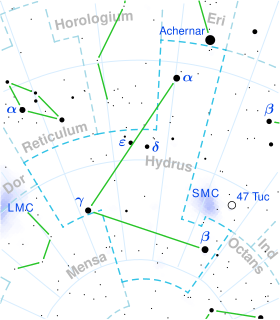Star in the constellation Hydrus
Epsilon Hydri , Latinized from ε Hydri, is a single, blue-white hued star in the southern constellation of Hydrus . It is a faint star with an apparent visual magnitude of 4.12, but it can be seen with the naked eye. Measurements made by the Hipparcos spacecraft showed an annual parallax shift of 21.48 mas , which provides a distance estimate of 152 light years . The star is moving away from the Sun with a radial velocity of +13.6 km/s. It is a member of the Tucana-Horologium moving group , an association of stars that share a common motion through space.
The stellar classification for this star is B9 Va, indicating that is it a B-type main-sequence star that is generating energy through hydrogen fusion at its core . It is a young star, just 133 million years in age, and has a high rate of spin with a projected rotational velocity of 96 km/s. This is giving the star a mild oblate shape with an equatorial bulge that is 5% greater than the polar radius. Epsilon Hydri has an estimated 2.64 times the mass of the Sun and 2.2 times the Sun's radius . It is radiating 60 times the Sun's luminosity from its photosphere at an effective temperature of around 10,970 K.
References
^ Van Leeuwen, F. (2007). "Validation of the new Hipparcos reduction". Astronomy and Astrophysics . 474 (2): 653–664. arXiv :0708.1752 . Bibcode :2007A&A...474..653V . doi :10.1051/0004-6361:20078357 . S2CID 18759600 . Vizier catalog entry
^ Anderson, E.; Francis, Ch. (2012). "XHIP: An extended hipparcos compilation". Astronomy Letters . 38 (5): 331. arXiv :1108.4971 . Bibcode :2012AstL...38..331A . doi :10.1134/S1063773712050015 . S2CID 119257644 . Vizier catalog entry
^ Mallama, A. (2014). "Sloan Magnitudes for the Brightest Stars". The Journal of the American Association of Variable Star Observers . 42 (2): 443. Bibcode :2014JAVSO..42..443M . Vizier catalog entry
^ Gontcharov, G. A. (2006). "Pulkovo Compilation of Radial Velocities for 35 495 Hipparcos stars in a common system". Astronomy Letters . 32 (11): 759–771. arXiv :1606.08053 . Bibcode :2006AstL...32..759G . doi :10.1134/S1063773706110065 . S2CID 119231169 .
^ Zorec, J.; Royer, F. (2012). "Rotational velocities of A-type stars". Astronomy & Astrophysics . 537 : A120. arXiv :1201.2052 . Bibcode :2012A&A...537A.120Z . doi :10.1051/0004-6361/201117691 . S2CID 55586789 . Vizier catalog entry
Allende Prieto, C.; Lambert, D. L. (1999). "Fundamental parameters of nearby stars from the comparison with evolutionary calculations: Masses, radii and effective temperatures". Astronomy and Astrophysics . 352 : 555–562. arXiv :astro-ph/9911002 . Bibcode :1999A&A...352..555A . Vizier catalog entry
^ David, Trevor J.; Hillenbrand, Lynne A. (2015). "The Ages of Early-Type Stars: Strömgren Photometric Methods Calibrated, Validated, Tested, and Applied to Hosts and Prospective Hosts of Directly Imaged Exoplanets". The Astrophysical Journal . 804 (2): 146. arXiv :1501.03154 . Bibcode :2015ApJ...804..146D . doi :10.1088/0004-637X/804/2/146 . S2CID 33401607 . Vizier catalog entry
Eggleton, P. P.; Tokovinin, A. A. (September 2008), "A catalogue of multiplicity among bright stellar systems", Monthly Notices of the Royal Astronomical Society , 389 (2): 869–879, arXiv :0806.2878 , Bibcode :2008MNRAS.389..869E , doi :10.1111/j.1365-2966.2008.13596.x , S2CID 14878976 .
Bell, Cameron P. M.; et al. (November 2015), "A self-consistent, absolute isochronal age scale for young moving groups in the solar neighbourhood", Monthly Notices of the Royal Astronomical Society , 454 (1): 593–614, arXiv :1508.05955 , Bibcode :2015MNRAS.454..593B , doi :10.1093/mnras/stv1981
Belle, G. T. (2012). "Interferometric observations of rapidly rotating stars". The Astronomy and Astrophysics Review . 20 (1): 51. arXiv :1204.2572 . Bibcode :2012A&ARv..20...51V . doi :10.1007/s00159-012-0051-2 . S2CID 119273474 .
Categories :
Epsilon Hydri
Add topic
Text is available under the Creative Commons Attribution-ShareAlike License. Additional terms may apply.
**DISCLAIMER** We are not affiliated with Wikipedia, and Cloudflare.
The information presented on this site is for general informational purposes only and does not constitute medical advice.
You should always have a personal consultation with a healthcare professional before making changes to your diet, medication, or exercise routine.
AI helps with the correspondence in our chat.
We participate in an affiliate program. If you buy something through a link, we may earn a commission 💕
↑
